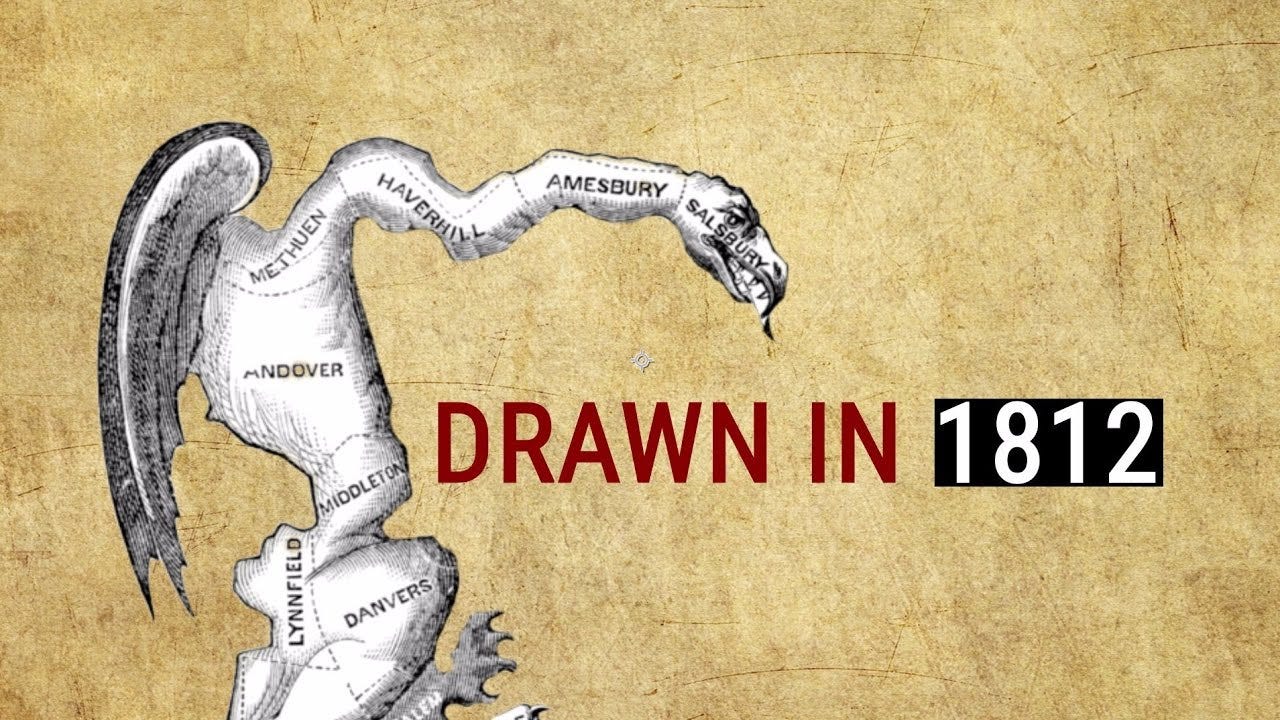The Twisted Map: A History of Gerrymandering and Democracy's Unfinished Battle
From Hand-Drawn Salamanders to Algorithmic Districts, How Map Manipulation Warps
Representation and Why Solutions Remain Elusive
In 1812, the Massachusetts state legislature, controlled by the Democratic-Republican Party, redrew the state’s senate districts to favor their party and weaken the Federalists. Despite its obvious political intent, Governor Elbridge Gerry signed the redistricting bill into law.
One district in particular was so oddly shaped that it resembled a salamander. A Federalist newspaper cartoonist, Elkanah Tisdale, drew a satirical illustration of the district as a mythical creature, dubbing it the “Gerry-mander”, a portmanteau (often catchy or descriptive terms) of “Gerry” (the governor’s last name) and “salamander.”
Thus, “gerrymandering” was born as a term for manipulating electoral boundaries for political advantage. The practice predates the name, but the term has stuck ever since.
Gerrymandering is the deliberate distortion of electoral boundaries for political gain. Today, sophisticated algorithms enable microscopic voter targeting, creating districts where politicians choose voters rather than voters. Despite centuries of practice, we fail to grasp its full corrosive impact on representative government.
Timeline: The Evolution of Electoral Manipulation
How Gerrymandering Skews Democracy
Federal Elections
North Carolina (2016): Republicans won 10 of 13 congressional seats with 53% of the votes. Courts ruled the map an "extreme outlier" in partisan bias.
Pennsylvania (2012): Democrats won 51% of votes but secured only 5 of 18 seats due to GOP-drawn maps.
State Legislatures
Wisconsin (2018): Democrats won 54% of statewide assembly votes but only 36% of seats.
Alabama (2023): Despite a 27% Black population, only 1 of 7 districts was majority-Black until Allen v. Milligan forced reform.
Local Impacts
Detroit: Black voters "packed" into District 13, diluting influence in neighboring districts.
South Carolina (2024): The Supreme Court upheld a map accused of racial bias, requiring plaintiffs to prove race was the "predominant factor".
The Supreme Court’s Enabling Role
The Court has alternately restrained and empowered gerrymandering through landmark rulings:
Shelby County v. Holder (2013): Struck down Section 4(b) of the Voting Rights Act, ending federal oversight of discriminatory maps in high-risk states. This triggered a wave of restrictive laws in 23 states.
Rucho v. Common Cause (2019): The court declared partisan gerrymandering "beyond the reach of federal courts," emboldening extreme map manipulation. Chief Justice Roberts conceded it was "incompatible with democratic principles" but insisted states and Congress must solve it.
Allen v. Milligan (2023): Temporarily bolstered voting rights by upholding Section 2, forcing Alabama to add a second majority-Black district.
Alexander v. South Carolina NAACP (2024): Raised the bar for racial gerrymandering claims, requiring proof that race, not politics, was the "predominant factor" in map-drawing.
These rulings create a paradox: The Court condemns gerrymandering but blocks federal remedies, making racial discrimination claims harder to prove.
Stopping Gerrymandering: Solutions in Progress
1. Independent Redistricting Commissions (IRCs)
How they work: Citizen panels (not politicians) draw maps using neutral criteria: contiguity, community integrity, and partisan fairness.
Success stories:
Michigan’s IRC reduced partisan bias by 40%, creating the nation’s most competitive maps.
California’s commission eliminated safe seats, doubling competitive districts.
Limitations: Only 12 states use IRCs; politicians often resist ceding power.
2. Federal Legislation
The Redistricting Reform Act of 2024 (introduced by Sens. Klobuchar and Butler) would:
Ban partisan gerrymandering nationwide.
Mandate transparent map-drawing with public input.
Protect communities of interest and minority representation.
However, the bill remains stalled in a divided Congress.
3. Technological Vigilance
PlanScore.org: Analyzes district maps for partisan bias using "efficiency gap" metrics.
Algorithmic Auditing: Tools like Districtr enable citizens to draw and test fair maps.
4. Legal Advocacy
State courts: Challenges under state constitutions (e.g., Pennsylvania’s Supreme Court struck down GOP maps in 2018).
Voting Rights Act: Section 2 lawsuits remain viable post-Allen, but face higher burdens after Alexander.
5. Proportional Representation
Systems like multi-member districts with ranked-choice voting could eliminate gerrymandering by decoupling geography from representation. This approach faces political hurdles but is used in over 80 democracies.
The Future: A Precipitous Crossroads
Gerrymandering’s trajectory hinges on three unresolved tensions:
Technological Arms Race: AI enables precision gerrymandering and real-time detection. Who controls the tools determines outcomes.
Judicial Volatility: The Supreme Court’s wavering stance, upholding voting rights in Allen while weakening them in Alexander, creates legal uncertainty because of Robert’s court.
Demographic Shifts: As communities diversify, gerrymandering increasingly targets minority voters. Louisiana’s pending Callais case could completely gut Section 2 of the Voting Rights Act.
Without robust federal intervention, the 2030 redistricting process risks entrenching minority rule in pivotal states, allowing a shrinking political faction to wield disproportionate control over legislatures and congressional delegations. Yet, a growing body of evidence and activism points toward actionable solutions to restore fairness and public trust in the electoral process.
Independent Redistricting Commissions (IRCs): Demonstrating What’s Possible
Independent Redistricting Commissions (IRCs) have emerged as a proven antidote to partisan map manipulation. IRCs have shown that fair, competitive, and representative maps are achievable by removing the responsibility for drawing district lines from self-interested legislators and placing it in the hands of impartial citizens. States like Michigan and California have led the way, demonstrating that IRCs can reduce partisan bias by up to 40% and increase the number of competitive districts. These commissions operate under transparent rules, prioritize public input, and are held accountable to neutral criteria such as contiguity, respect for community boundaries, and avoiding partisan favoritism. Their success offers a blueprint for reform at both the state and federal levels.
Grassroots Mobilization: The Power of Citizen Action
Grassroots movements, such as Michigan’s Voters Not Politicians, illustrate the potential for ordinary citizens to reclaim control over redistricting. In Michigan, a coalition of volunteers collected hundreds of thousands of signatures to place a redistricting reform initiative on the ballot, ultimately passing a constitutional amendment establishing an independent citizen commission. Similar efforts are underway in states nationwide, driven by organizations that educate voters, organize petition drives, and hold elected officials accountable. These movements demonstrate that public engagement can drive meaningful change even in the face of entrenched political interests.
Legislative and Judicial Pathways to Reform
Legislative action remains essential to scaling these successes nationwide. Federal proposals such as the Redistricting Reform Act and the Freedom to Vote Act seek to ban partisan gerrymandering, mandate transparent map-drawing processes, and protect minority representation. While these bills have faced obstacles in a divided Congress, sustained public pressure can help break the logjam and advance comprehensive reform.
Judicial oversight also plays a critical role. Interpreting their constitutions, state courts have struck down gerrymandered maps in states like Pennsylvania and North Carolina. Meanwhile, federal courts continue to address racial gerrymandering under the Voting Rights Act despite the Supreme Court’s reluctance to intervene in partisan gerrymandering cases (Rucho v. Common Cause). Judicial accountability ensures that even without federal legislation, legal challenges can provide a check on the most egregious abuses.
Technological Tools and Public Oversight
Advancements in technology have made it easier than ever for citizens to monitor and challenge unfair maps. Platforms like PlanScore.org and Districtr enable anyone to analyze district boundaries for partisan bias and propose alternative, fairer configurations. These tools empower activists, journalists, and ordinary voters to hold mapmakers accountable and demand greater transparency in the redistricting process.
The Way Forward: A Multi-Pronged Strategy
The path to fair redistricting requires a combination of public pressure, legislative courage, and judicial accountability.
Public pressure must continue to build through grassroots organizing, voter education, and advocacy campaigns highlighting the harms of gerrymandering and the benefits of reform.
Legislative courage is needed to pass laws establishing independent commissions, banning partisan gerrymandering, and ensuring that every community’s voice is heard.
Judicial accountability must be maintained through vigilant litigation and by appointing judges committed to protecting voting rights.







Gerrymandering IS THE threat to undermining our democracy as is DESTROYS fair elections entirely.
Thank you, I wrote down PlanScore.org down as it’s essential that we stop Trump’s Agenda